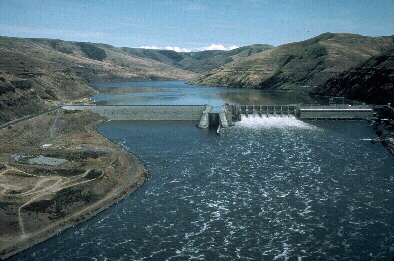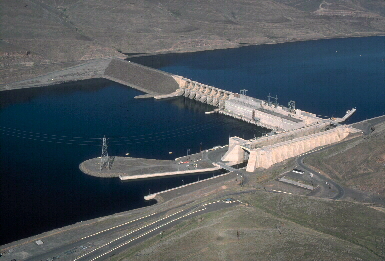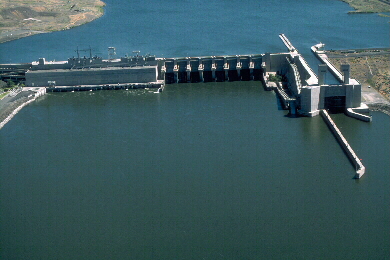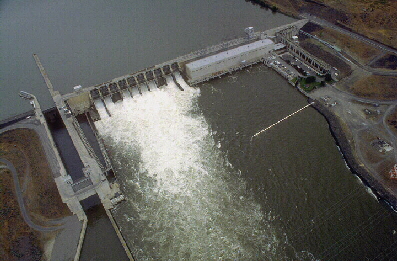the film
forum
library
tutorial
contact
|

|
Idaho U.S. Rep. Simpson Proposing Sweeping $32 Billion
'Columbia Basin Fund' to Finance Lower Snake River Dam Breaching
by Staff
Columbia Basin Bulletin, February 5, 2021
|
 Idaho Republican U.S. Rep. Mike Simpson has been discussing with regional parties a $32 billion "Columbia Basin Fund" to finance the breaching of the lower Snake River dams, new energy technologies to replace the lost hydropower, and compensation to communities and businesses that depend on the dams.
Idaho Republican U.S. Rep. Mike Simpson has been discussing with regional parties a $32 billion "Columbia Basin Fund" to finance the breaching of the lower Snake River dams, new energy technologies to replace the lost hydropower, and compensation to communities and businesses that depend on the dams.
The Columbia Basin Fund is aimed at providing "certainty, security, and viability" in removing the dams to boost the struggling populations of Snake River salmon and steelhead listed under the Endangered Species Act. Regional goals are that Columbia/Snake river salmon and steelhead runs produce smolt-to-adult returns of 2 to 6 percent, with 4 percent SAR over time considered a recovery number. ESA-listed Idaho fish have been running below 2 percent.
One goal of Simpson's sweeping proposal is to "end salmon litigation." It calls for a "35-year Columbia Basin Dam Litigation Moratorium." (Basin salmon recovery has been in the courts for nearly 30 years.)
It also calls for the Bonneville Power Administration to be "removed from direct fish management duties."
Simpson's staff presentations at various briefings suggest the comprehensive Columbia Basin Fund be created in a congressional stimulus/infrastructure funding bill. It would be fully funded in the first year, with funds administered by the Dept. Of Energy. A Senate-confirmed "Columbia Basin Fund Special Administrator" would be selected, and the organization would be headquartered at PNNL in the Tri-Cities.
 Under "salmon conservation," the fund would spend billions of dollars on not only breaching the dams, but on joint state/tribal fish management, agricultural waste management, renewable investments, Northwest watershed partnerships, Hells Canyon sturgeon protection, salmon conservation corps, lamprey passage, priority salmon investments, and upper basin restored non-ESA protected runs.
Under "salmon conservation," the fund would spend billions of dollars on not only breaching the dams, but on joint state/tribal fish management, agricultural waste management, renewable investments, Northwest watershed partnerships, Hells Canyon sturgeon protection, salmon conservation corps, lamprey passage, priority salmon investments, and upper basin restored non-ESA protected runs.
The proposal is suggesting a Northwest Fish and Wildlife Council where basin tribes become "co-equal primary Northwest fish managers." Tribes, too, would receive hundreds of millions in annual block grants and funding for Lower Snake River cultural resource protection.
For the Northwest states, the proposal, at least in early conception, would send billions to states for Northwest grid resiliency, animal waste research and development, annual block grants, dam mitigation and indemnification program, a Snake River Center for Advanced Energy Storage, and many of the other categories under "salmon conservation" listed above.
For "communities" under the proposal, it is suggested that over $2 billion will go to a Snake River Center for Advanced Energy Storage to be co-located at PNNL and Lewiston-Clarkston, technology partnership grants, Lewiston-Clarkston waterfront, tourism promotion for Tri-Cities area, Tri-Cities Economic Development Fund, Tri-Cities/Lewiston Clarkston Infrastructure Development Fund, commercial industry fund, Tri-Cities Ports/Intermodal Transportation Hub, Snake River Ports, and tourism promotion for Lewiston-Clarkston area.
 Under "recreation," the plan, post-breaching, calls for designating the lower Snake River a national recreation area.
Under "recreation," the plan, post-breaching, calls for designating the lower Snake River a national recreation area.
If approved it would send millions to a Lower Snake River recreation fund, Lower Snake River tourism promotion for Tri-Cities/Spokane and Lewiston-Clarkston, Lower Snake River recreational boating compensation, and Lower Snake River marina relocation fund.
Under the key issue of "transportation," Simpson's proposal calls for "Lower Snake River Corridor Grain Transportation" program with an early funding number at $1.5 billion.
The proposal would also send hundreds of millions to Lewiston-Clarkston ports, agricultural handlers (coops/commerical elevators), Lower Snake River corridor road and rail study and mitigation, Tri-Cities ports, and Lower Snake River corridor waterway shippers (barging/tour).
Under "energy," the proposal is suggesting billions for Lower Snake Dams energy replacement to BPA, that Columbia Basin dams be "locked in" with 35-year hydro license extensions, a salmon spill energy replacement to BPA (one number is $1.5 billion), end salmon litigation (35-year litigation moratorium), Northwest grid resiliency and optimization, and dam mitigation and indemnification program.
And what about BPA, which through regional ratepayers is the leading funder of Columbia Basin salmon and steelhead mitigation?
The Simpson plan, at least preliminarily, calls for BPA borrowing authority be increased to $15 billion from current $7.7 billion, BPA fish mitigation be met with one annual capped payment of $600 million a year, and BPA be removed from direct fish management duties.
 It also calls for BPA to receive several billion dollars for salmon spill energy replacement, Northwest grid resiliency and optimization. BPA receives federal credits for fish and wildlife fixed expenses, credits for legacy irrigation costs, and deauthorizing Willamette Valley dams.
It also calls for BPA to receive several billion dollars for salmon spill energy replacement, Northwest grid resiliency and optimization. BPA receives federal credits for fish and wildlife fixed expenses, credits for legacy irrigation costs, and deauthorizing Willamette Valley dams.
Official details of the Simpson proposal are expected to be released in the coming days.
It's not surprising such a proposal would come out of Simpson's office. In April, 2019, at a keynote speech during an Andrus Center environmental conference on salmon, energy, agriculture and community at Boise State University, Simpson said "we should not manage salmon just to keep them off the extinction list. We should manage them to bring back a healthy, sustainable population in Idaho."
He suggested at that time a "Northwest Power Act 2.0."
"You cannot address the salmon issue without addressing dams," he said. "You cannot address the salmon issue without addressing the challenges the BPA has. They are interwoven."
Simpson told the conference he was ready to look at the necessary steps to restoring Idaho's salmon.
"One of the challenges I am going to have to face sooner rather than later is I am going to have to sit down with the Pacific Northwest (congressional) delegation, Republicans and Democrats, and tell them what I am doing," Simpson said in 2019.
As word this week circulated about the Simpson plan, those opposed to removing the dams, sent out responses Thursday. The CBB will continue to add to reactions as issued.
REACTION:
Northwest RiverPartners:
US Rep. Mike Simpson (R -- Idaho) has started discussions about a multi-billion-dollar proposal that could dramatically change the way electricity is provided and goods are delivered across the Pacific Northwest. The sheer magnitude of the plan and its timing, amid a federal stimulus push, has captured the region's attention. Behind the plan is Rep. Simpson's hope to put an end to the decades-long legal battle over salmon restoration and the lower Snake River dams.
The proposal, which continues to evolve, would create a $32 billion Columbia Basin Fund with many objectives, but the primary aim is to finance the breaching of the lower Snake River dams and to replace them with alternative forms of clean energy and batteries. Because the dams enable other critical benefits, such as transportation and irrigation, the fund would also attempt to compensate the many communities, farms, and businesses that depend on the dams as a mainstay for their livelihoods.
We are encouraged that the scale of the plan's budget reflects the tremendous value that the lower Snake River dams bring to the region. That long-debated topic is effectively put to rest by the proposal's significant price tag.
Like Rep. Simpson, we also have a vision for regional collaboration that moves the Northwest beyond the courtroom and towards partnership. This collaboration is in the best interest of recovering threatened and endangered salmon populations while we work to achieve a clean and equitable energy future for all of our residents. We appreciate that the Simpson plan clearly reflects extensive input of tribal nations and hundreds of stakeholder groups.
At the same time, Northwest RiverPartners has long-opposed breaching the lower Snake River dams. We truly believe that carbon-free hydroelectricity is an important part of the solution to the salmon crisis. It is also a critical part of providing affordable, clean electricity to the region's vulnerable communities.
While we remain open-minded about the Simpson proposal, there are several key issues in the plan that need to be addressed before we can consider it a fair and equitable solution for our Northwest communities.
First, we believe the case for breaching to save salmon lacks scientific rigor. Given the Pacific Coast-wide declines in salmon survival in both dammed and undammed rivers, it is hard to make the case that breaching dams with advanced fish passage technology will reverse this disturbing trend.
In addition, a growing body of science suggests warming, acidifying oceans are the driving factor behind worldwide declines in marine fish populations, including salmon. Breaching the lower Snake River dams does nothing to address this issue.
In fact, the Simpson proposal substantially increases the region's C02 output by eliminating low-carbon barging and shifting transported goods to semi-trucks and rail. This shift could result in hundreds of thousands of additional tons of C02 in our atmosphere each year.
If sustainable salmon populations don't return to the Snake River, US taxpayers will have footed the bill to the tune of tens of billions of dollars to end up with a larger carbon footprint than we have today.
We are also concerned by the speculative nature of the plan's energy replacement component. Hydropower and pumped storage dams are proven technologies that we can depend on, but long-duration utility-scale batteries and small modular nuclear reactors are still very much in the exploratory stage. We welcome the advancement of these technologies, but the region's electric customers should not be made reliant on technological breakthroughs to keep the lights on.
We also urge a more circumspect approach to the topic of litigation. The Simpson plan includes a 35-year moratorium on salmon-related lawsuits against dam operators, but with the multitude of laws and regulations governing waterways, we are worried the plan may fall short. We are particularly concerned that state jurisdiction under the Clean Water Act provides an open door for additional legal actions. As it stands, the proposed moratorium seems ripe for a legal challenge and warrants additional safeguards.
Many families in the Northwest rely on dam-dependent employment, whether they are seasonal farm workers or riverboat operators. Any plan around dam removal must consider how we specifically support these families. As we've learned throughout the pandemic, a check from the government cannot make up for the loss of one's career. We must ensure the transition of livelihoods for those who rely on the lower Snake River dams.
We believe Rep. Simpson's plan has the best of intentions, and it deserves to be vetted among Northwest stakeholder groups. However, considering the extremely high stakes involved, we cannot afford to ignore the need for a much more thorough analysis of what the plan can actually deliver and the deep impact it may have on our diverse Northwest communities.
Northwest RiverPartners (NWRP) is a not-for-profit, member-driven organization. We represent not-for-profit, community-owned utilities across Washington, Oregon, Idaho, Montana, Wyoming, and Nevada. We also proudly represent farmers, ports, and businesses across the region that support clean energy and low-carbon transportation.
Pacific Northwest Waterways Association:
The Pacific Northwest Waterways Association has reviewed a plan proposed by Rep. Mike Simpson (R, ID-2) to establish a $32 billion "Columbia Basin Fund" for regional economic and environmental transition. The highlight of Rep. Simpson's plan is the breaching of the four Lower Snake River dams.
PNWA appreciates that Rep. Simpson has highlighted two issues in this plan on which almost everyone in the Pacific Northwest can agree: commitment of real dollars for salmon recovery, and increased utilization of renewable, carbon-free energy to combat climate change.
However, funding for salmon recovery and new energy technologies should not be tied to an extreme measure like breaching the Snake River dams, which provide over 95% effective fish passage and are a critical part of the region's energy portfolio. These dams also make possible fuel-efficient, low-carbon, safe and reliable barge transportation.
"This plan would remove highly functional run-of-river dams with world-class fish passage that provide fundamental benefits like clean energy and efficient commerce to our region, and put the region on track for higher carbon emissions and an increase in climate change. It is not a responsible use of taxpayer dollars, and ultimately is a disservice to our region's fish," said PNWA Executive Director Kristin Meira.
"Rep. Simpson's proposal to replace barging on the Snake River with additional rail and truck traffic would lead to significant carbon emission increases in our region at a time when our leaders have pledged to move us in a greener direction. While rail and truck are important and have their place in our region, those two modes also have much higher rates of injuries and fatalities associated with them, when compared to barging. The impact to human life and safety in northern Idaho and eastern and central Washington should also be considered," Meira said.
The plan attempts to place a price tag on an entire region's way of life. While $32 billion may address some economic impacts of dam removal, no amount of money can protect the culture, lifestyle, and economies of the communities that depend upon the Columbia-Snake River System's hydropower, navigation, irrigation, flood risk management, recreation, and municipal and industrial water supply benefits.
The proposal also fails to take a system-wide approach, and relies on investments and technologies that are uncertain at this time. It identifies solutions that do not adequately address the adverse impacts on human safety, carbon dioxide emissions, trade, or broader economic and community impacts, among others.
This plan continues to pursue an extremely narrow focus on four projects with outstanding fish passage, despite multiple reports from the scientific community about ocean warming, ocean acidification, urban runoff and other issues that are leading to declines in fish runs throughout the West Coast, including those in undammed rivers.
NOAA Fisheries started a conversation with its Columbia Basin Partnership Task Force to evaluate all Northwest runs, set goals for recovery, and highlight the multitude of actions that it will take to help our fish. Discussions are now happening about the best way to continue that good work. PNWA encourages Rep.
Simpson and other parties in the Northwest to reject extreme and narrow approaches like Snake River dam breaching, and collaborate on regionwide efforts to help West Coast runs in every part of their life cycle.
Related Sites:
Columbia Basin Collaborative Schedules Organizational Workshop to Discuss 'Proposed Process Approach'; Goal to Create 'Salmon Ethic' by Staff, Columbia Basin Bulletin, January 29, 2021
Idaho's 'Salmon Workgroup' Submites Policy Recommendations to Governor; No Consensus on Dam-Breaching by Staff, Columbia Basin Bulletin, January 8, 2021
Oregon Files Intent to Challenge Feds' New EIS/BiOp for Basin Salmon/Steelhead in Case Regional Collaboration Goes Nowhere by Staff, Columbia Basin Bulletin, December 11, 2020
Staff
Idaho U.S. Rep. Simpson Proposing Sweeping $32 Billion 'Columbia Basin Fund' to Finance Lower Snake River Dam Breaching
Columbia Basin Bulletin, February 5, 2021
See what you can learn
learn more on topics covered in the film
see the video
read the script
learn the songs
discussion forum


 Idaho Republican U.S. Rep. Mike Simpson has been discussing with regional parties a $32 billion "Columbia Basin Fund" to finance the breaching of the lower Snake River dams, new energy technologies to replace the lost hydropower, and compensation to communities and businesses that depend on the dams.
Idaho Republican U.S. Rep. Mike Simpson has been discussing with regional parties a $32 billion "Columbia Basin Fund" to finance the breaching of the lower Snake River dams, new energy technologies to replace the lost hydropower, and compensation to communities and businesses that depend on the dams.
 Under "salmon conservation," the fund would spend billions of dollars on not only breaching the dams, but on joint state/tribal fish management, agricultural waste management, renewable investments, Northwest watershed partnerships, Hells Canyon sturgeon protection, salmon conservation corps, lamprey passage, priority salmon investments, and upper basin restored non-ESA protected runs.
Under "salmon conservation," the fund would spend billions of dollars on not only breaching the dams, but on joint state/tribal fish management, agricultural waste management, renewable investments, Northwest watershed partnerships, Hells Canyon sturgeon protection, salmon conservation corps, lamprey passage, priority salmon investments, and upper basin restored non-ESA protected runs.
 Under "recreation," the plan, post-breaching, calls for designating the lower Snake River a national recreation area.
Under "recreation," the plan, post-breaching, calls for designating the lower Snake River a national recreation area.
 It also calls for BPA to receive several billion dollars for salmon spill energy replacement, Northwest grid resiliency and optimization. BPA receives federal credits for fish and wildlife fixed expenses, credits for legacy irrigation costs, and deauthorizing Willamette Valley dams.
It also calls for BPA to receive several billion dollars for salmon spill energy replacement, Northwest grid resiliency and optimization. BPA receives federal credits for fish and wildlife fixed expenses, credits for legacy irrigation costs, and deauthorizing Willamette Valley dams.
